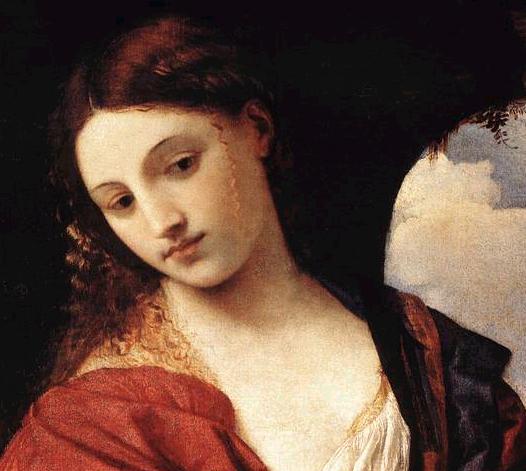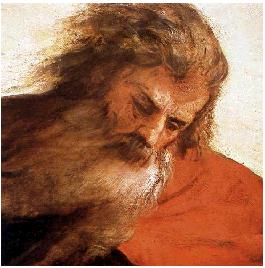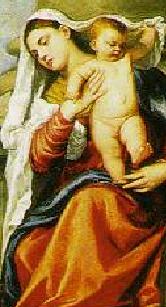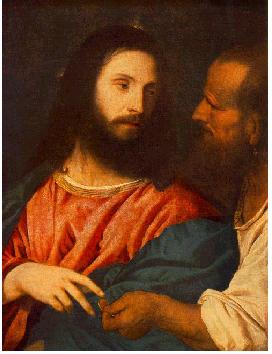
Candida Martinelli's Italophile Site

Main
Page This family-friendly site celebrates Italian culture for the enjoyment of children and
adults. Site-Overview
Knights of Art -
Titian
Visit
my Angels in Italian Art Page
Visit
my Canaletto and Venice Art Page On-line images of art at Web
Gallery of Art: We
have seen how most of the great painters loved to paint into their
pictures those scenes which they had known when they were boys, and
which to the end of their lives they remembered clearly and vividly. A
Giotto never forgets the look of his sheep on the bare hillside of
Vespignano, Fra Angelico paints his heavenly pictures with the colours
of spring flowers found on the slopes of Fiesole, Perugino delights in
the wide spaciousness of the Umbrian plains with the winding river and
solitary cypresses. Judith (detail) by Titian So
when we come to the great Venetian painter Titian we look first with
interest to see in what manner of a country he was born, and what were
the pictures which Nature mirrored in his mind when he was still a boy. At
the foot of the Alps, three days' journey from Venice, lies the little
town of Cadore on the Pieve, and here it was that Titian was born. On
every side rise great masses of rugged mountains towering up to the sky,
with jagged peaks and curious fantastic shapes. Clouds float around
their summits, and the mist will often wrap them in gloom and give them
a strange and awesome look. At the foot of the craggy pass the
mountain-torrent of the Pieve roars and tumbles on its way. Far-reaching
forests of trees, with weather-beaten gnarled old trunks, stand firm
against the mountain storms. Beneath their wide-spreading boughs there
is a gloom almost of twilight, showing peeps here and there of deep
purple distances beyond. Assumption of the Virgin
(detail) by Titian Small
wonder it was that Titian should love to paint mountains, and that he
should be the first to paint a purely landscape picture. He lived those
strange solemn mountains and the wild country round, the deep gloom of
the woods and the purple of the distance beyond. Assumption of the Virgin
(detail) by Titian The
boy's father, Gregorio Vecelli, was one of the nobles of Cadore, but the
family was not rich, and when Titian was ten years old he was sent to an
uncle in Venice to be taught some trade. He had always been fond of
painting, and it is said that when he was a very little boy he was found
trying to paint a picture with the juices of flowers. His uncle, seeing
that the boy had some talent, placed him in the studio of Giovanni
Bellini. But
though Titian learned much from Bellini, it was not until he first saw
Giorgione's work that he dreamed of what it was possible to do with
colour. Thenceforward he began to paint with that marvellous richness of
colouring which has made his name famous all over the world. At
first young Titian worked with Giorgione, and together they began to
fresco the walls of the Exchange above the Rialto bridge. But by and by
Giorgione grew jealous. Titian's work was praised too highly; it was
even thought to be the better of the two. So they parted company, for
Giorgione would work with him no more. Madonna with Saints (detail)
by Titian
Venice
soon began to awake to the fact that in Titian she had another great
painter who was likely to bring fame and honour to the fair city. He was
invited to finish the frescoes in the Grand Council-chamber which
Bellini had begun, and to paint the portraits of the Doges, her rulers. These
portraits which Titian painted were so much admired that all the great
princes and nobles desired to have themselves painted by the Venetian
artist. The Emperor Charles V himself when he stopped at Bologna sent
to Venice to fetch Titian, and so delighted was he with his work that he
made the painter a knight with a pension of two hundred crowns. Holy Family by Titian Fame
and wealth awaited Titian wherever he went, and before long he was
invited to Rome that he might paint the portrait of the Pope. There it
was that he met Michelangelo, and that great master looked with much
interest at the work of the Venetian artist and praised it highly, for
the colouring was such as he had never seen equalled before. `It
is most beautiful,' he said afterwards to a friend; `but it is a pity
that in Venice they do not teach men how to draw as well as how to
colour. If this Titian drew as well as he painted, it would be
impossible to surpass him.' Gypsy Madonna by Titian But
ordinary eyes can find little fault with Titian's drawing, and his
portraits are thought to be the most wonderful that ever were painted.
The golden glow of Venice is cast like a magic spell over his pictures, and in him the great Venetian school of
colouring reaches its height. Besides
painting portraits, Titian painted many other pictures which are among
the world's masterpieces. He
must have had a special love for children, this famous old Venetian
painter. We can tell by his pictures how well he understood them and how
he loved to paint them. He would learn much by watching his own little
daughter Lavinia as she played about the old house in Venice. His wife
had died, and his eldest son was only a grief and disappointment to his
father, but the little daughter was the light of his eyes. Tribute Money by Titian We
seem to catch a glimpse of her face in his famous picture of the little
Virgin going up the steps to the temple. The little maid is all alone,
for she has left her companions behind, and the crowd stands watching
her from below, while the high priest waits for her above. One hand is
stretched out, and with the other she lifts her dress as she climbs up
the marble steps. She looks a very real child with her long plait of
golden hair and serious little face, and we cannot help thinking that
the painter's own little daughter must have been in his mind when he
painted the little Virgin.
Return to: Stories of the Italian Painters
by Amy Steedman






